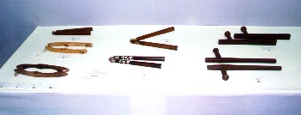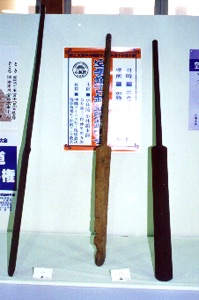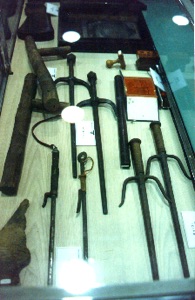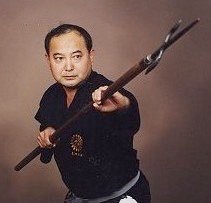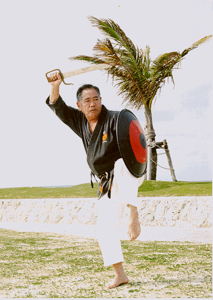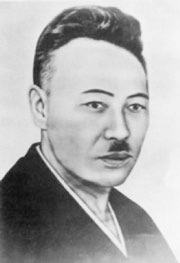Matayoshi Kobudo
Okinawa Kobudo
The Matayoshi Kobudo system was formed by the work of two remarkable instructors -- father and son, who dedicated their lives to leave us the legacy of their style. Matayoshi Shinko Sensei and his son, Matayoshi Shinpo Sensei, through their system, influenced many other Kobudo schools, which are practiced today. Gakiya Yoshiaki Sensei Instructed Calandra Sensei in the art of Kobudo to preserve their legacy and further this rare, ancient art.
Weapons
The following is a list of the most important weapons taught today in the
SEISHINKAN DOJO
The practice of some of these weapons is limited to certain rank or seniority of the practitioners within the system.
Bo, Sai, Tonfa, Nunchaku, Ieku, Nunti, Kama, Tekko, Tinbe, Sansetsu-kon, Kuwa, Suruchin, Chizikun Bo, Jo

Michael Calandra
Michael Calandra began his training in 1979. He began his study of Kobudo in 1981. In 1997 he travelled to Okinawa and became a direct student of Gakiya Yoshiaki 8th Dan. He is ranked 6th Dan. For Calandra Sensei’s full Bio click here.
l-r Yogi Sensei, Calandra Sensei, Gakiya Sensei.

Gakiya Yoshiaki
Gakiya Yoshiaki Sensei was born February 8, 1950 in Yomitan Ouki Okinawa. He completed his military service and learned Juken-do there.
Gakiya Sensei began his martial arts training in 1967 with Fukuchi Seiko Sensei in Goju-ryu Karate.
He began the study of Kobudo in 1975 at the famous Kodokan dojo with Matayoshi Shinpo Sensei. Gakiya Sensei was awarded his teaching certificate in Kobudo on February 21, 1980 from Matayoshi Sensei and the Zen Okinawan Kobudo Federation. Gakiya Sensei also studied Kobayashi Shorin-ryu with Nakamura Yoshio since 1980.
On June 8, 1997, Gakiya Sensei received his hachi-dan (8th dan) in Kobudo. Gakiya Sensei achieved the status of head teacher at the Kodokan dojo and was appointed Kodokan Kancho by the Matayoshis after Matayoshi sensei's death. Gakiya Sensei was the closest collaborator of Matayoshi Sensei for more than 20 years. In July 2001, he retired from his position at the Kodokan dojo.
In 2011 Gakiya Sensei retired from active teaching because of health reasons.
Gakiya Yoshiaki Sensei 8th Dan

MATAYOSHI SHINPO
Matayoshi Shinpo Sensei, son of Matayoshi Shinko Sensei and successor to the Matayoshi line of Kobudo, was born in Okinawa in Yomitan Village, located in the Kina District on December 27, 1921. His father introduced Shinpo Sensei to the martial arts at the very young age of 6. However, Matayoshi Shinko Sensei did not limit his son to the practice of Kobudo; he also exposed Shinpo Sensei to Kingai Ryu, a White Crane open hand system. In 1937, Shinpo Sensei's father also introduced him to the open hand system of Hakaku Kempo, which he learned from Gokenki Sensei. Although Shinpo Sensei would have various instructors throughout his life, his father remained his life-long instructor and mentor.
Matayoshi Shinpo Sensei remained in Okinawa until 1938, when he moved to Kawasaki-Shi in Kanagawa-Ken. He spent 19 years in the city of Kawasaki teaching and training. The year 1957 brought Shinpo Sensei back to Okinawa, where he taught kobudo predominantly in Goju Ryu dojos, namely that of Higa Sensei. While teaching kobudo in various karate dojos, Matayoshi Sensei realized that karate was growing in popularity, where as kobudo was not. Matayoshi Sensei wanted to increase the exposure of kobudo among the people of Okinawa, so he decided to form his own dojo.
In 1960, Matayoshi Shinpo Sensei founded his kobudo dojo in the city of Naha, and he called it the "Kodokan" in memory of, and as a dedication to his teacher and mentor Matayoshi Shinko Sensei. The significance of "Kodokan" is based on the kanji "Ko" (meaning "Light"), and is a tribute to the "Ko" from Shinko; for what Kodokan translates to the "Hall of the Enlightened Way
Once Matayoshi Sensei opened his dojo, he focused on contacting Kobudo instructors and students all over Japan. His intention was to unite Kobudo practitioners under one goal; to not only to spread the art of Kobudo, but also to try to maintain the traditions that had been passed down from Kobudo Senseis of earlier days. Matayoshi Sensei had a strong interest in promoting Kobudo among young students to help make them better citizens and contributors to society. As a result of this interest, Matayoshi Sensei formed the Ryukyu Kobudo Association in 1960. This association became the foundation of the Zen Okinawa Renmei or All Okinawa Kobudo League, which formed in 1972 and still exists today.
Matayoshi Shinpo Sensei appointed Gakiya Yoshiaki as head of the system before he died. Matayoshi Sensei passed away in Okinawa on September 7, 1997, at the age of 76.
Matayoshi Shinpo Sensei 1921-1997

Matayoshi Shinko
Matayoshi Shinko Sensei or "Kama nu Matehi" (Matayoshi the Kama) as he was often called, was born in the city of Naha, Okinawa in 1888. As the third son of Matayoshi Shinchin, a wealthy businessman, Shinko was the only member of the family to become involved in the martial arts. Although Matayoshi Shinko, Sensei grew up predominantly in Okinawa, he traveled later on in his life around different areas of Japan and China. It was in Okinawa, Hokkaido, and China that Matayoshi Shinko Sensei received the majority of his exposure and training in various weapon arts. Matayoshi Shinko Sensei would later incorporate many of the weapons and styles of his instructors to form the foundation of what we know today as Matayoshi Kobudo system.
Matayoshi Shinko Sensei had the opportunity to experience the art of weapons from many different instructors. During his teens, Matayoshi began his training in kobujutsu, under the instruction of Agena Chokuho Sensei of Gushikawa Village. From Agena Sensei, Matayoshi learned Bo-jutsu, Sai-jutsu, Kama-jutsu, and leku-jutsu.
Matayoshi Shinko Sensei then became the student of Irei Sensei of Nozato, Chatan Town, from whom he learned the arts of Tonkua-jutsu and Nunchaku-jutsu.
Not long after, at the age of 22, Matayoshi Shinko Sensei left on an adventure to Manchuria where he joined a mounted nomadic tribe, from whom he gained exposure in the arts of Ba-jutsu (bow and arrow while riding a horse), Shuriken-jutsu, and Nagenawa-jutsu (rope throwing).
Shinko Sensei continued in his travels to expand his knowledge of the art of weaponry, arriving in Shanghai where he learned the arts of Nunti-jutsu, Tinbei-jutsu, and Suruchin-jutsu. while in Shanghai, he began to develop interests outside of kobudo, yet still within the realm of the martial arts. Matayoshi Shinko Sensei became involved in the study of Chinese acupuncture and herbal medicine under the instruction of Kinkoroushi. He furthered his studies in China, learning Chinese boxing and Shorinji-Kempo in Fuchow, China.
Because of his abilities and knowledge, windows of opportunity were opened to Matayoshi Shinko Sensei, and he was able to participate in two very notable moments in the history of the martial arts. In 1915, during the Imperial Memorial Budo Demonstration Festival at the Meiji Shrine in Tokyo, Shinko Sensei demonstrated Tonkua-jutsu and Kama-jutsu, while Funakoshi Gichin Sensei (the founder of Shotokan) demonstrated karate. This was the first time that Okinawan Kobudo was publicly demonstrated in mainland Japan, and remains a very important event in the history of Kobudo. Later, in 1921, during the honorable visit of Prince Hirohito (Showa) to Okinawa, Matayoshi Sensei demonstrated Kobudo, and Miyagi Chojun Sensei (the founder of Goju Ryu) demonstrated Karate for the distinguished guest. It was not until 1935 when Matayoshi Shinko Sensei returned to Okinawa, settled in the city of Naha, and shaped his experiences to the point of developing the Matayoshi style of Kobudo. Matayoshi Shinko Sensei passed away in 1947 at the age of 59.
Matayoshi Shinko Sensei 1888-1947

MULTI WEAPONED ART OF THE OKINAWA
The ancient history of Okinawa tells us a turbulent story, with violent political upheavals characterizing a major part of the now-peaceful island's heritage. It was out of these days of unrest that the art of kobudo (the ancient martial way) was born, due to a necessity for peasants to defend their families or property by turning common, everyday items into weapons that could be used for self defense. In times of political strife, war faring weapons such as swords and spears were forbidden to the general populace, which left farmers and fishermen easy prey for armed bandits and pirates. To counteract the decrees that rendered them weaponless, Okinawans as well as the inhabitants of the other islands within the Ryukyuan chain became highly proficient in the use of implements such as water-bucket carrying poles, boat oars, and grist mill handles as means of self protection. Kata were eventually developed, usually named after a founder or village of origin, and various styles of kobudo came into being. One of these traditional systems is the Matayoshi style of kobudo practiced by the Seishinkan Dojo, which is now recognized world-wide as a leader in the art that was so desperately needed and so carefully developed to preserve the well-being of the Ryukyuan citizenry.
The Okinawa Kobudo taught at the Seishinkan has deep roots in the teachings of Shinko Matayoshi (1888-1947), who comes from a family that has one of the oldest lineages on Okinawa, and is distinctive in that every member has been involved in the martial arts to some degree. The unusually wide variety of weapons that are taught within the Matayoshi system evolved from the ability of Shinko Matayoshi to travel and learn all aspects of the art, as he spent a total of thirteen years studying in China, along with making frequent excursions to other areas to experience different cultures and learn about the weapons that were used for self defense. Shinko Matayoshi's later travels were for the purpose of promoting his system, which became known as Ryukyuan Kobudo throughout Okinawa and mainland Japan. Today, Shinko Matayoshi's work is upheld by his son, Shinpo Matayoshi (1923- ), who began training under his famous father's instruction at the age of four. Like his father, Shinpo Matayoshi (as pictured to the right in his Kodokan Dojo in Okinawa training with a sai that is unique to the Matayoshi Kobudo system as it is angled differently from the more common type) travels extensively to promote kobudo, and founded the Ryukyu Kobudo Renmei in 1970, which was reorganized two years later into the Zen Okinawa Kobudo Renmei. Shinpo Matayoshi's dojo is named Kodokan (Enlightened Way) in honor of his father, whose first name Shinko means "True Light."
The differences between Matayoshi Kobudo and other systems result from, a strong Chinese influence, which came about from Shinko Matayoshi's studies. Overall, the movements in the Matayoshi system are more relaxed and flowing, with both linear and circular strikes forming a smooth, fluid style. While the stepping movements within Matayoshi Kobudo are somewhat similar to those used in Okinawan karate, the stances are designed differently for very quick, light movements. For example, the foot positioning for the sumo stance (shiko dachi) is not as wide, and the front foot positioning of the cat stance (neko ashi dachi) is dissimilar from that used in karate and other kobudo styles. The Chinese influence also becomes apparent in bo (wooden staff) techniques where chambering of the close end of the weapon takes place outside the arm, rather than under the arm. Positioning the bo on the outside of the arm lends greater protection to the inner part of the body, and avoids the injuries that could occur when the bo whips around and snaps up under the user's arm, striking vulnerable areas in the armpit and side of the torso.
The Matayoshi Kobudo system places great emphasis on the use of the bo, an implement said to be derived from the tenbib, which was a wooden staff that was slung across the shoulders in order to transport buckets of water on each end. The most popular type of bo is the rokushaku, which measures six feet in length and 1 1/4 inches thick at the center, tapering down to 3/4 inch at the ends. Other types of bo range in length from four to nine feet, and can be round (maru-bo), four-sided (kaku-bo), sixsided (rokkaku-bo), or eight-sided (hakkakubo). The most common bo kata are Shushi- No-Kon, Choun-No-Kon, Sakugawa-No-Kon, Tsuken-No-Kon, and Shiishi-No-Kon. Other staff-type weapons include the hanbo (threefoot wooden stick), jo (four-foot wooden stick), tetsubo (Iron staff), sansetsu-kon (three-sectioned staff), and the konsaibo, which is a wooden staff studded with iron nubs.
Many traditional Okinawan kobudo weapons were developed to defend against opponents wielding spears or swords. Implements such as the sai, which is a three-pronged metal truncheon, were often used in sets of two or three for the purpose of entrapping an attacker's weapon and using the pronged ends in a jabbing, puncturing strike. Although the exact origin of the sai is obscure, it closely resembles an instrument that was used in China, and is also believed to have been derived from a farming implement that was used for digging furrows in the ground for planting seeds. A third sai was often carried behind the back in the belt sash (obi) as a replacement for a hand-held sai that was thrown at an opponent. The nunti is a three pronged weapon that is sometimes incorrectly referred to as a manji-sai, with one of the outside prongs facing in the opposite direction, toward the handle, and which often attached to the end of a bo. Other truncheon weapons are the jutte and the tokushu-keibo, a collapsible metal instrument.
The nunchaku is a weapon made from a horse bridle strap and a tool that was used to pound grain or rice. In the Matayoshi system, the most common types of nunchaku have octagonal (hakkakukei) or round (maru-gata) wooden handles of equal length connected by a length of rope or chain. A vine (kanda) can also be used as a longer connector, in order to bind an opponent's head and hands together in an "Okinawan Handcuff." Matayoshi Kobudo instruction includes nunchaku with one handle half the length of the other, both handles half the normal size, three-sectioned and four-sectioned. The han-kei nunchaku, with the circumference of the handles halved, is designed for easier carrying and concealment, as both handles fit together smoothly. Sickles that became useful weapons for self defense includes the kama, which has a curved blade, and the naginata, a curved blade, sickle like spear seven feet in length. The nagemaki is a heavier version of the naginata with a larger blade, while the rokushaku-kama is a sickle with a six foot handle.
Wooden implements played an important role in the history of kobudo, and tools such as the tunkwa (tuifa, tonfa), which were used as grist mill handles, served as effective weapons. The eku (boat oar) was a popular item in Okinawan fishing villages, and has a unique feature in allowing the defender to fling sand in an attacker's face by holding the eku straight up with the paddle end down, and kicking the bottom out in a swift, forward and upward motion. There is also the abumi (wooden saddle stirrup) and the tecchu ("knuckle-duster") made from yarn spindles.
Chizikanbo, made from wooden fish floats, is another weapon that is attached to the hands to aid punching effectiveness. The bokken, or wooden sword, was employed as a training device, while the kendo practice sword made of bamboo shoots (shinai) served as a conditioning implement.
Knife-like weapons that could be concealed within clothing and easily produced when needed are the kaiken (six- inch knife), juken (bayonet), and the tanto (dagger with a blade measuring eight to sixteen inches in length). Another device is the ninshokudai, or candles on an L-shaped, iron-spiked holder that was said to be carried by Okinawan women.
Chains produced large, heavier weapons such as the suruchin (Manriki-gusari), which was weighted at one end, and the gekigan (ball and chain). The chigiriki is a weapon that has a three-to-ten-foot chain attached to an iron ball at one end and a staff at the other end. The nagegama is a retractable walking stick made from chain links.
Other items on the lengthy list taught in the Matayoshi Kobudo system include the halberd, a heavy, axe-like weapon with a coin-shaped blade. The tecchu is another form of "brass knuckles," as is the tetsuko, which is made of metal and studded. The tinbe (timbei, tembe, timpei), which is a shield made from the shell of a giant sea turtle, proved effective for repelling sword or spear attacks, and was often used with the small dart-like weapon known as rochin.
It must be pointed out that the study of the multitude of weapons in the Matayoshi system takes place on a complete basis, and students are not encouraged to merely dabble in various areas in an attempt to "learn a little bit about each weapon." The founding master's principles are based upon thorough knowledge of the purpose and origin of each weapon, and it takes many years of dedicated training to become proficient in the use of a single item.
Matayoshi Kobudo has become very popular among practitioners of the major Okinawan karate styles, as it fits in well with empty-hand arts and rounds out a student's martial training. One of the traditional Okinawan principles concerns the fact that Gakiya Sensei views kobudo as not only an art for self defense, but also serves as a means of obtaining and maintaining inner peace.

Okinawa Kobudo
Shinchin Matayoshi
Shinko Matayoshi
Shinpo Matayoshi
Yoshiaki Gakiya
Michael Calandra
For information on Okinawa Kobudo Classes and Seminars
Contact:
Seishinkan
260 Jericho Turnpike
Floral Park, NY 11001
Phone: 917-667-0739
Email: oikddojo@aol.com

